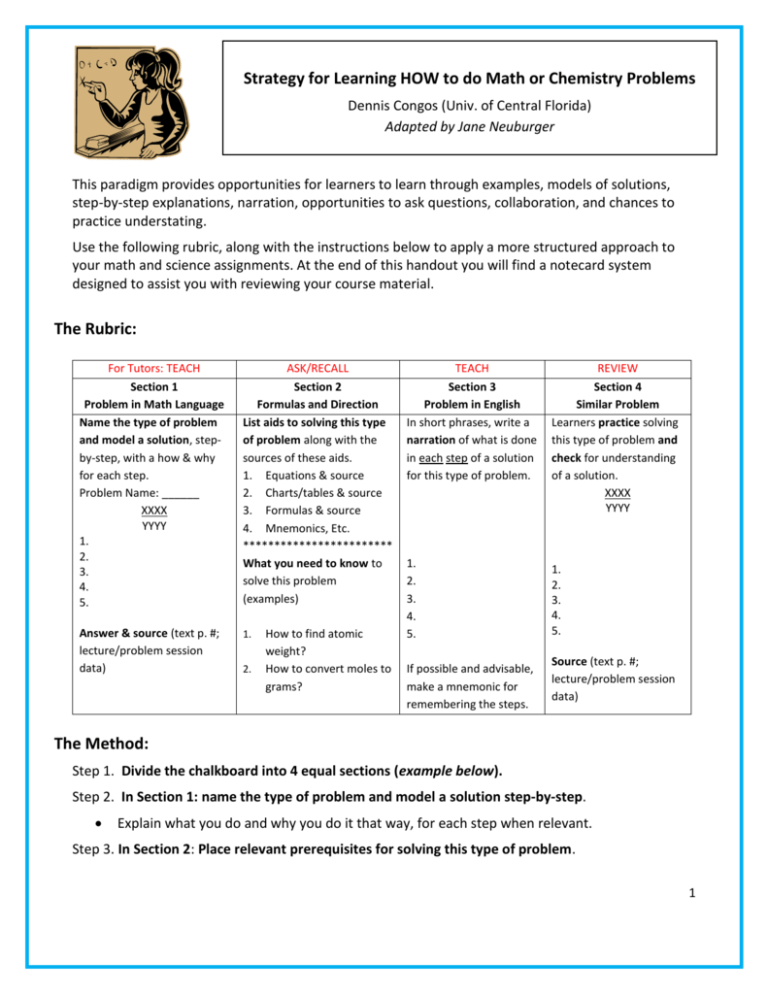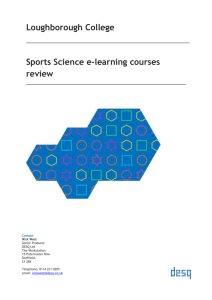The Review - Tutoring and Study Center
advertisement

Strategy for Learning HOW to do Math or Chemistry Problems Dennis Congos (Univ. of Central Florida) Adapted by Jane Neuburger This paradigm provides opportunities for learners to learn through examples, models of solutions, step-by-step explanations, narration, opportunities to ask questions, collaboration, and chances to practice understating. Use the following rubric, along with the instructions below to apply a more structured approach to your math and science assignments. At the end of this handout you will find a notecard system designed to assist you with reviewing your course material. The Rubric: For Tutors: TEACH Section 1 Problem in Math Language Name the type of problem and model a solution, stepby-step, with a how & why for each step. Problem Name: ______ XXXX YYYY 1. 2. 3. 4. 5. ASK/RECALL Section 2 Formulas and Direction List aids to solving this type of problem along with the sources of these aids. 1. Equations & source 2. Charts/tables & source 3. Formulas & source 4. Mnemonics, Etc. ************************ What you need to know to solve this problem (examples) Answer & source (text p. #; lecture/problem session data) 1. 2. How to find atomic weight? How to convert moles to grams? TEACH Section 3 Problem in English In short phrases, write a narration of what is done in each step of a solution for this type of problem. REVIEW Section 4 Similar Problem Learners practice solving this type of problem and check for understanding of a solution. XXXX YYYY 1. 2. 3. 4. 5. 1. 2. 3. 4. 5. If possible and advisable, make a mnemonic for remembering the steps. Source (text p. #; lecture/problem session data) The Method: Step 1. Divide the chalkboard into 4 equal sections (example below). Step 2. In Section 1: name the type of problem and model a solution step-by-step. Explain what you do and why you do it that way, for each step when relevant. Step 3. In Section 2: Place relevant prerequisites for solving this type of problem. 1 Include formulas you’ll need, and what you are solving for – the “direction” of the problem. Return to and update Section 1 as needed. Step 4. In Section 3: Write the words for what is done in each step from Section 1. This narration becomes their guide for solving this type of math problem in the future. When finished, ask for questions and be ready to explain what you did and why for each step in the solution. Explain everything – DO NOT SKIP STEPS. Step 5. In Section 4: When there are no more questions, put a similar problem in Section 4 for learners to practice and check for understanding. If they get stuck, they are now armed with prerequisites, a model of a solution, verbal rules for a solution, and the knowledge of the study session leader, tutor, instructors, or collaboration peers, depending on the nature of the group. Step 6. When learners finish the practice problem, the study session leader, instructor, tutor, or learner places each step of a solution on the board in Section 4. The person offering a solution should explain: (1) what was done in each step, (2) why it was done that way and (3) how to verify if it is the correct answer. The Benefits: It demonstrates the importance of listing and knowing essential prerequisites. i.e. formulas, equations, charts, diagrams, mnemonics, etc. needed to solve each type of math/science problem. Learners see a model of how to solve each type of problem. Watching and hearing others think through solutions, including explanations of what is done and why it is done for EACH STEP in a solution. It demonstrates the thinking process, and demystifies the learning process. Rules for solving each type of problem are written on the board for students to include in their notes. Rules consist of a step-by-step problem-solving narration. This is done to include students whose learning styles have verbal skills as the primary style of learning. The narration is a tremendous aid to these students (indispensable for some) who traditionally have difficulty with quantitative problem solving. The narration allows them to bring to bear these often neglected but better developed verbal skills when dealing with quantitative information. Learners are given a chance to practice and/or be sure they are correct. Learners who “believe” that they understand how to do a problem without verifying it through practice are taking a risky venture. Instructors, SI leaders, or tutors should not accept at face value the verbal assurances of understanding without creating an opportunity for learners to test their understanding. Students see where information comes from on how to solve each type of problem. 2 They are more likely to refer to these sources as guides to solving current and future problems. Students are not “told” how to solve problems. Teaching can’t take place unless there is learning. Telling the learner how to solve a problem typically yields little success in helping them understand the solution. Remember: this paradigm provides opportunities for learners to learn through examples, models of solutions, step-by-step explanations, narration, opportunities to ask questions, collaboration, and chances to practice understating. Learners can easily convert information from the board to notecards. They can then practice solving problems and check for what they have learned and discover what they have yet to learn before an exam is taken- when something can still be done about it. The Review: Below is a model of how to set up a notecard to organize and speed the understanding and learning of math problems and solutions: Sections 1 and 2 should be on the front of a notecard and Section 3 on the back. Learners practice by looking at a problem and doing a solution from memory before turning the card over to check for understanding. Front of card: Put prerequisites here: 1. 2. 3. 4. 5. 6. Equations: source Charts: source Tables: source Formulas: source Mnemonics: source Skills learners must have to solve the problem: Name the type of problem here: XXXXXXXXXXXX Put the problem here: XXXX YYYY For example: Back of Card: Put steps in a solution here: 1 2 3 4 5 Answer: include the source for this correct answer. Put the rules, the words that describe what is done in each step here: 1 2 3 4 5 If possible, a mnemonic or memory aid to remember the steps in a solution. 3







